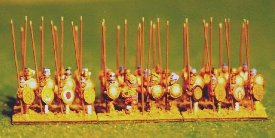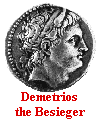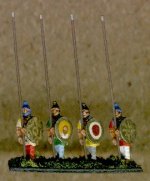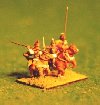 | |||||||||||||||||
Antigonid Army - DBA #38a |
| Xystophoroi (Companions), a possible General stand. | ||
| Allied or mercenary Greek cavalry | ||
| Tarantine light horse. Antigonos seems to have introduced the soon-to-be ubiquitous Tarantines, who began the practice of carrying a shield while fighting mounted. Median or Persian light horse also could have served in Antigonos' army, if you prefer a bit more colourful castings. | ||
| The phalanx. About a third of these would be pantodapoi, Easterners armed and trained in the Macedonian fashion, but led by Macedonian officers. General stand may be included as a Pike element, if led by Antigonos. Although most Successor generals emulated their dead King Alexander and commanded surrounded by Companions, Antigonos in his final battle dismounted and fought with the phalanx. | ||
| Mercenary peltasts. These troops would not be using the oval shield, as later Theurophoroi were to do. Smaller circular or the traditional crescent shaped pelte would be employed. | ||
| Javelinmen or Asiatic archers. | ||
| The elephant. De rigeur among the Diadochi. Note that at this early date, crew rode directly atop the elephant; towers were not yet in usage. |
Enemies
- Antigonos was the most successful of Alexander's Generals after the breakup of his empire. He certainly earned his kingdom, fighting an endless sequence of wars.
 He fought the Midianite Arabs (#5), who represent Antigonos' (unsuccessful) attempt to conquer the Nabateans, entered a hardfought but ultimately victorious campaign against Eumenes (#38b), faced Lysimachos (#39) the unpopular ruler of Thrace, and engaged in a series of wars against Seleucus (#41a) and Ptolemy (#42a). Antigonos also fought against the existing kingdoms of Asia Minor, represented (I think) by the inclusion of Early Armenians (#44) which Alexander had bypassed on his quest to destroy the Persian Empire. There are, however, some reservations I have about the Early Armenians as an enemy of the Antigonid army.
He fought the Midianite Arabs (#5), who represent Antigonos' (unsuccessful) attempt to conquer the Nabateans, entered a hardfought but ultimately victorious campaign against Eumenes (#38b), faced Lysimachos (#39) the unpopular ruler of Thrace, and engaged in a series of wars against Seleucus (#41a) and Ptolemy (#42a). Antigonos also fought against the existing kingdoms of Asia Minor, represented (I think) by the inclusion of Early Armenians (#44) which Alexander had bypassed on his quest to destroy the Persian Empire. There are, however, some reservations I have about the Early Armenians as an enemy of the Antigonid army.The DBA list of possible enemies seems to oddly be missing Pyrrhus (#43), Macedonian Early Successor (#40) and Later Hoplite Greek (#32). Cassander, as represented by the Macedonian Early Successor, list fought Antigonid generals in Greece in 313 BC and later faced Antigonos' son Demetrios in Europe for about three years. After Ipsus in 301 BC, Demetrios attempted to retake Greece, and after Cassander's death, Macedonia. The Boeotians, Athens and Sparta (all best described by the Later Hoplite Greeks #32), as well as Pyrrhus opposed his attempts to found a new kingdom.
It seems that the enemy list has been limited to foes that only Antigonos himself faced in person, but the ending date of 285 BC clearly indicates that this army list extends to the end of Demetrios. I would definitely amend the list of Antigonid enemies to include these three foes. The Antigonid army list itself might also be changed slightly from "..., 1x3Cv,..." to include an option of "..., 1x4Sp or 1x3Cv,..." to represent the Athenian Hoplite volunteers that assisted Demetrios during his first sojourn in Greece. Fewer cavalry than usual were present with Demetrios during this time.
Historical Notes
-
Antigonos Monophthalmos "the One-Eyed" was an officer in Philip's army, probably losing his eye at the siege of Perinthos. Under Alexander he was a trusted and skilled officer, serving in battle with Alexander before being given the position of Satrap of Phrygia. Alexander's confidence in Antigonos to guard the important land-route back to Macedonia was not misplaced. Antigonos defeated three separate Persian counterattacks despite being outnumbered. (DBA note: For these early battles I'd suggest using DBA army #36)
After the death of Alexander in 323 BC, the high ranking officers in the Macedonian army began quickly quarreling among themselves. Antigonos, through a combination of military skill, shrewd diplomacy and of course, luck, rose to prominence as the leading Successor kingdom. It is doubtful whether he ever intended to replace Alexander. He was pragmatic, and released his weak hold on the Eastern half of Alexander's empire to Seleucus in return for a truce. His attempts to secure Greece and Macedonia, sources of manpower for the Hellenistic armies, were more determined, although ultimately unsuccessful. Antigonos was able (until the final War) to defeat the coalitions against him in detail, either diplomatically or militarily.
 His son Demetrios Poliorcetes "The Besieger" was not as talented an organizer as his father. His sobriquet was given during his failed siege of Rhodes. However he was the designated heir of Antigonos, so was given several important independent commands, including campaigns against Ptolemy and Cassander. Although he managed to win some battles, his tactics lost others - including the crucial final battle of Ipsus in 301 BC where Antigonos was killed. After Ipsus Demetrios roamed the Hellenistic world striving to regain a kingdom, but to no avail, being defeated by Pyrrhus, Lysimachos and Seleucus. He ended his days drinking himself to death in custody of the Seleucid kingdom.
His son Demetrios Poliorcetes "The Besieger" was not as talented an organizer as his father. His sobriquet was given during his failed siege of Rhodes. However he was the designated heir of Antigonos, so was given several important independent commands, including campaigns against Ptolemy and Cassander. Although he managed to win some battles, his tactics lost others - including the crucial final battle of Ipsus in 301 BC where Antigonos was killed. After Ipsus Demetrios roamed the Hellenistic world striving to regain a kingdom, but to no avail, being defeated by Pyrrhus, Lysimachos and Seleucus. He ended his days drinking himself to death in custody of the Seleucid kingdom. Army Tactics
-
Like all Successor armies, the Antigonid army is a mixture of troop types. Such a balanced force can be extremely effective, but it takes some delicate handling.
 Obviously the major part of the army is the phalanx of pike. Keep it together - pikes operate best in one large unstoppable mass. In good going, nothing can destroy it in a frontal assault (barring any lucky rolls from warband or knights). Pike is actually most vulnerable to massed bows, but fortunately for Antigonos, his historical opponents never possessed such a formation. Always try to keep it slowly grinding forward, to constrict your opponents' freedom of maneuver. For your opponent it is quite disconcerting to see a wall of six pike stands slowly bearing down upon him.
Obviously the major part of the army is the phalanx of pike. Keep it together - pikes operate best in one large unstoppable mass. In good going, nothing can destroy it in a frontal assault (barring any lucky rolls from warband or knights). Pike is actually most vulnerable to massed bows, but fortunately for Antigonos, his historical opponents never possessed such a formation. Always try to keep it slowly grinding forward, to constrict your opponents' freedom of maneuver. For your opponent it is quite disconcerting to see a wall of six pike stands slowly bearing down upon him.Phalanxes must always stay in good going, and watch their flanks. Since they are most effective in a double line, their frontage is limited. Antigonid armies possess one Auxilia and one Psiloi element which should be used to secure bad going patches on the flanks of the pike block.
 The mounted arm, consisting of one Light Horse, one Cavalry and one Knight, is both a strength and a weakness. Try to use it en masse mostly- move it only as fast as the slow moving xystophoroi (Knights). Although the light horse may sometimes be used to threaten exposed enemy flanks, particularly against enemy phalanxes. The single KN element, being forced to followup winning combats, usually has a short lifespan.
The mounted arm, consisting of one Light Horse, one Cavalry and one Knight, is both a strength and a weakness. Try to use it en masse mostly- move it only as fast as the slow moving xystophoroi (Knights). Although the light horse may sometimes be used to threaten exposed enemy flanks, particularly against enemy phalanxes. The single KN element, being forced to followup winning combats, usually has a short lifespan.I like to (OK - attempt to) use the horse, particularly the KN, in reserve to be held until the phalanx has pushed back the enemy enough to expose a weak flank. Then throw the KN into the gap and smash through. Historically this is often how Alexander used his elite Companions.
As for that single Elephant - it's powerful, but awkward. It, or any group containing it, takes two pips to move, which can be crucial. I'd suggest using holding the Elephant in reserve, to react against any enemy horse breakthrough. Although don't forget to leave room for front line elements to retreat; recoiling elements do not push back elephants but are destroyed. I have seen some players surround it with a pike formation, but it comes off second best in a push-of-pike contest. And once your pikemen become disordered it can take far too many pips to rally the unit into a solid line once again with that elephant in the centre of the battle line.
Links to Related Websites
- Antigonos Jonatas. Although the pictures are of castings intended for a later army (that of Antigonos' grandson), both the superb painting and page design are striking. Very inspiring - and a lesson to those who still think that linen armour is always a boring white.
Midianite Arabs. Doug Kendrick's pictures and some notes of his DBA #5 Midianite army.
Early Armenians. Another display of Doug Kendrick's collection; this time Early Armenians (DBA #44).
Alexandrian Macedonian. The army list from the DBA Resource Page. The soldiers in Alexander's army and those of the early Successors were, by and large, identical.
Hellenistic History. An online synopsis of this period.
Demetrius A translated copy of Plutarch's life of Demetrius from MIT.
Lysimachos An internal link to my history of Lysimachos.
Gabiene, 315 BC. Another internal link to a DBA scenario of the final battle between Antigonos and Eumenes. Bibliography
- M. M. Austin, The Hellenistic World, Cambridge University Press.
- Richard Billows, Antigonos the One-Eyed, University of California Press.
- Here's an online book review of Billows' work.
Diodoros, Books XVII, XVIII, XIX and XX, Harvard University Press.
Duncan Head, Armies of the Macedonian and Punic Wars, Wargames Research Publication Group.
Plutarch, Life of Demetrius, Penguin.
F. W. Walbank, The Hellenistic World, Harvard University Press.Visit the DBA Resource Page Bookstore to buy these and other Classical histories.
Home ~ Battles ~ Links ~ Armies ~ Rules ~ Anecdotes ~ What's New? ~ Email ~ Figures ~ Conventions - Richard Billows, Antigonos the One-Eyed, University of California Press.









